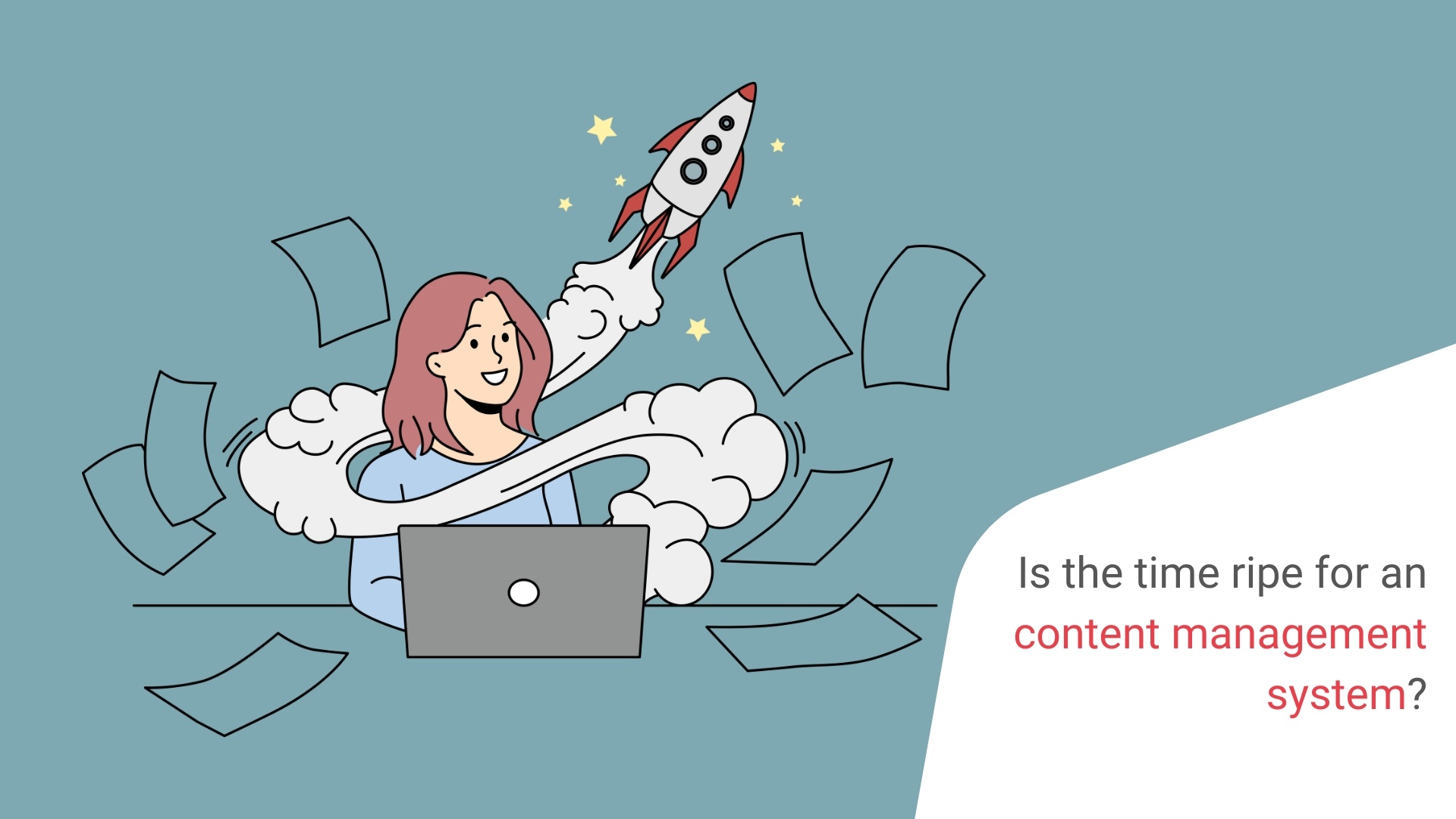High efficiency, optimal reuse and dynamic content management:
modern content management systems offer many advantages over classic word processing software. How can you find out if a system like this is also right for your technical editorial team?
We’ll show you.
Sand in the editorial gearbox
The technical editorial department is no exception: if the current software tool is not right for the team’s requirements, processes will quickly stall and productivity will drop.
What does it mean for the day-to-day work of an editorial team if the software doesn’t do what it should? In my consulting projects, I repeatedly come across scenarios like the following:
- Delivery dates cannot be met
The machine is standing around ready for delivery, but the urgently needed instructions are missing: in addition to staffing bottlenecks, problems with the technical processes are a frequent reason why an editorial team cannot fulfill their tasks 100%. - The editorial team gets frustrated
In most cases, creating technical documentation means working in a team, often across different locations. Software that does not fit the needs of the editorial team quickly causes discrepancies and negatively impacts the motivation of colleagues. - Editorial processes do not run smoothly
Have all the links in the operating manual been checked? Why haven’t the translators received the new texts yet? And who changed the document again after it was approved? Creating a manual consists of many individual steps with a range of very different people involved. If this process does not have optimum technical support, this usually leads to time-consuming additional expenses due to manual rework.
When is the right time?
In addition to these soft factors, there are of course also concrete reasons for purchasing a content management system. What are they specifically?
Let’s take a closer look at the technical environment in an editorial office: in many companies, a classic word processing program such as Microsoft Word is still the most important tool when it comes to creating the documentation. The advantages are obvious: in most cases, the program is already installed on the computers and everyone is familiar with the basic functions. However, for more complex tasks – such as documenting the varied products in mechanical and plant engineering – an ordinary word processing program soon reaches its limits. In practice, this often leads to similar problems.
The most common five are:
Managing content is complicated and time-consuming
Reuse existing content as efficiently as possible: this principle is the be-all and end-all for anyone who wants to create manuals in a structured and efficient way. In a word processing program, the traditional method for this is usually: copy-and-paste. The problem here is that you have to update the copied content in different places if something changes. As a result, it is often not clear: which content component is used where? What content is still up to date? And how is our standard content organised? Even with simple adjustments, the workload can be immense, as the following example demonstrates: shortly before the end of the project, one of the product’s technical values changes. This value now has to be changed manually in the Word document at each relevant point. Not only does this take time, it also has enormous potential for errors.
The advantage of the content management system: here, the content is not recorded in a continuous document, but in smaller units, known as modules. This way, you only need to adjust the value once in the appropriate module. The change is now automatically applied at all points where a link to the original module is created. This form of reuse also prevents you from overlooking a relevant point.
The layout and design of the instructions are not uniform
Too many cooks spoil the broth! Individually designed and structured instructions are a no-go in the world of documentation. Despite editorial guidelines and other standardisation tools, it is almost inevitable in practice that editors will incorporate their own style. The possibilities for individual design vary greatly however – depending on which software is used.
The disadvantage of word processing programs is that they give editors a particularly large scope for individualisation, e.g. direct formatting of text and layout. An uncontrolled proliferation of different designs and layout is thus almost inevitable in larger teams.
With a content management system, on the other hand, content and layout are strictly separated from each other. For the technical editors, this means that they have to deal significantly less with the visual design of the instructions and can concentrate fully on the content aspects of their work. The finished document is generated at the touch of a button thanks to predefined style sheet templates.
But the content management system offers far more than just cleanly laid out instructions. What we call the document type definition (DTD) defines the exact structure and layout of the various content elements in a manual. This helps the editors to always structure certain content, such as safety instructions, according to the same principle.
The editorial process is not optimally supported
Whether it’s version management, multi-stage releases or an automatic terminology check: many requirements of a technical editor simply cannot be implemented – or if so, then only inadequately – in a word processing program. The lack of technical support usually leads to extra work for the editors, and, in the worst case, results in individual tasks falling by the wayside.
Editorial systems for creating technical documentation have the advantage that they are designed specifically for the requirements of technical editorial departments. This means they inherently have the necessary tools to optimally support and automate editorial processes.
Digitisation and media diversity are neglected
Whether you’re working remotely from a smartphone or on site at the machine’s control panel – digital user information is becoming more important all the time. The new publication channels also pose technical challenges for those responsible for information. One key issue to remember: despite different output formats, the content should be managed centrally in a media-neutral manner in order to keep the maintenance effort as low as possible. This requires solutions that go beyond what a conventional word processing program can do.
How can we do this better? A modern content management system uses the same XML data for each file format but generates different target formats from this data as necessary – for example, a PDF to be sent to the printing press or HTML for integrating the instructions into the machine’s control system. Content management systems also play an important role in content delivery. The aim of this approach is to make digital user information especially easy to access from a central online platform (known as a content delivery portal). The content management system acts as a data source for all documentation content that is then made available via the interface through the content delivery portal. A meaningful structure and the right metadata management ensure that the content is optimally prepared in the content management system for later publication in the CDP.
Translation management is chaotic
A smooth translation process plays a key role in the creation of technical documentation. However, classic text editing programs usually make it difficult for technical editors to manage the translated texts effectively. For example, a document-based way of working often means that when changes are made, the entire manual is once again sent off for translation, even though only a few passages of text are affected. This happens especially when the editors do not know which content has already been translated and which target texts are still up to date.
Here, too, the content management system scores points with its modular structure and consistent reuse of content: content that has been translated already is simply referenced and does not need to be re-translated – this saves time and costs. The translation process can also be initiated with just a few mouse clicks via an interface to the translation memory system. The same applies when it comes to importing the translation packages back into the content management system.
In the foreseeable future, it will even be possible to translate content directly in the content management system using integrated machine translation tools.
The next steps
Have you come any closer to deciding whether a content management system is right for your company?
In any case, the scenarios described here offer a good orientation for further consideration. If any of these situations are familiar from your day-to-day editorial work, you should definitely take a closer look at the topic of content management systems.
Before taking any further steps, it is fundamentally important to know exactly what your own requirements for the new system are. My recommendation would be to arrange a kick-off workshop with your editorial team: it’s the best way to analyse and evaluate your department’s wishes, requirements and goals. And don’t forget that other departments will also have expectations of the new system. You should therefore get the responsible stakeholders – e.g. from IT, design, marketing or sales – on board in good time, not forgetting to systematically record their requirements.
Do you have questions about content management systems or do you need specific support? Feel free to contact me and we can discuss the individual situation of your editorial team together.

